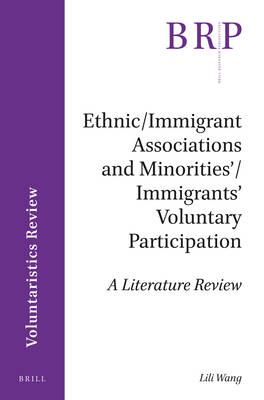
- Afhalen na 1 uur in een winkel met voorraad
- Gratis thuislevering in België vanaf € 30
- Ruim aanbod met 7 miljoen producten
- Afhalen na 1 uur in een winkel met voorraad
- Gratis thuislevering in België vanaf € 30
- Ruim aanbod met 7 miljoen producten
Zoeken
Ethnic/Immigrant Associations and Minorities'/Immigrants' Voluntary Participation
Lili Wang
€ 128,45
+ 256 punten
Omschrijving
Migration has changed the social, cultural, political, and economic landscape of many countries. Mutual aid organizations, ethic-oriented religious organizations, hometown associations, and various other types of ethnic and immigrant organizations emerged to respond to the particular needs of immigrant communities. For countries with a tradition of civic participation, integrating immigrants into civic life becomes an important issue. This article reviews the literature on ethnic/immigrant associations and minorities' or immigrants' voluntary participation in major developed countries that have experienced a significant increase of immigrants, particularly after the 1990s. In terms of ethnic/immigrant associations, the author reviews the historical background of research in this area, the size and scope, the formation and development, the memberships, and the financial well-being of these associations, the roles they play in helping immigrants acculturate into the host countries, and the classification of ethnic/immigrant associations. Particular attention is given to immigrants' mutual aid organizations, ethnic cultural organizations, ethnic-oriented religious organizations, and hometown associations. The author also reviews the literature that examines the factors influencing minorities' and immigrants' voluntary participation, their formal and informal volunteering, as well we immigrant youth's voluntary participation.
Specificaties
Betrokkenen
- Auteur(s):
- Uitgeverij:
Inhoud
- Aantal bladzijden:
- 108
- Taal:
- Engels
- Reeks:
- Reeksnummer:
- nr. 10
Eigenschappen
- Productcode (EAN):
- 9789004361867
- Verschijningsdatum:
- 15/02/2018
- Uitvoering:
- Paperback
- Formaat:
- Trade paperback (VS)
- Afmetingen:
- 155 mm x 234 mm
- Gewicht:
- 136 g

Alleen bij Standaard Boekhandel
+ 256 punten op je klantenkaart van Standaard Boekhandel
Beoordelingen
We publiceren alleen reviews die voldoen aan de voorwaarden voor reviews. Bekijk onze voorwaarden voor reviews.








